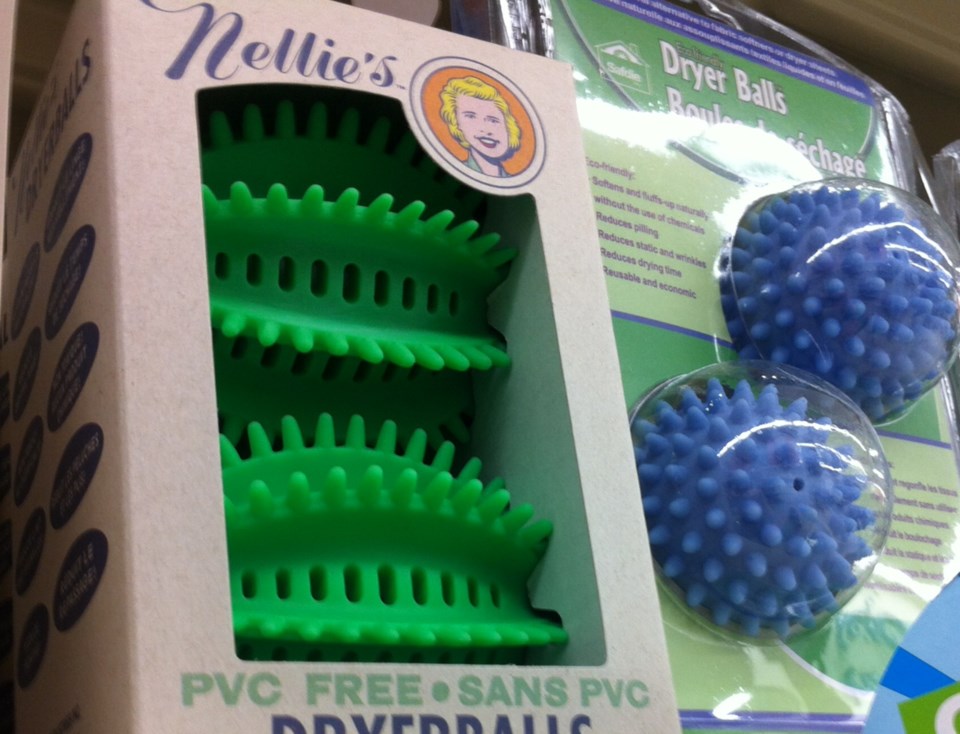
Dryer balls are baseball-sized balls that are typically made of rubber, plastic or fabric. The promotional material for them says when you put several in a clothes dryer they’ll hasten drying; they’ll also soften clothes and reduce static, serving as a substitute for chemical-based fabric sofeners.
I didn’t know that dryer balls existed until I encountered supportive mentions on the David Suzuki Foundation and B.C. Hydro websites.
[davidsuzuki.org: Wool dryer balls shrink drying time]
[bchydro.com: Shrink your dryer's energy use]
The theory behind using the balls is that they help to prevent laundry from clumping in the dryer. In doing so, the laundry dries more efficiently. The balls also retain heat and boost the drying process by passing along their warmth. After reading the instructions and promotional material for several brands of dryer balls, I am unclear about how they soften clothes and reduce static.
Several people have tested the dryer ball claims and have concluded that they generally do not reduce drying time.
A Grade 8 student in North Carolina, David Wicklin, conducted an experiment with dryer balls for a national science poster competition and won second place in his category. He did 20 loads of family laundry with dryer balls and another 20 without, and found that there wasn’t much difference in drying time. He worked out a way to make comparisons fair with the help of a scale.
The website urge4lessenergy.blogspot.ca also found that dryer balls make no difference to drying time.
The writer at Green Energy Efficient Homes went looking for evidence to back claims that dryer balls can reduce drying time by up to 25 per cent, and concluded that the balls are a gimmick.
Popular Mechanics checked the fabric softening claim and declared: “Difficult to detect a noticeable difference — other than increased noise — when dryng with the balls.”
On the other hand, the maker of this YouTube video is convinced that the balls reduce drying time. As for banishing static, she offers an unequivocal it doesn’t work.
And many of the commenters on Amazon.ca for Woolzies Dryer Balls insist they work. Sample headings: “Makes a Big Difference in Drying Time” and “they work great, remove static.”
Why do dryer balls appear to work for some people and not for so many others? After wading through all those articles, here’s my guess. It depends on what’s being dried. Laundry is not a set thing. Some people have a lot of natural fabrics, others lean to polyester. Some loads have a lot of small things, like socks and underpants which can spin about freely. Others have bedsheets and blankets that are prone to clumping, and might benefit from the pounding of dryer balls to loosen them up.
This would be a good topic for one of my favourite TV shows, Mythbusters. But the visuals might be lacking. Not a lot of TV excitement in having balls tumble about in a dryer.
- - -
- - -
Most-popular posts:
Review: B.C. Hydro’s EMU-2, energy monitor and nag
Figuring out how to eat unfamiliar foods properly, like dosa
Despite hassles, travellers pack public transit for ferry trips
To stay cool, leave house windows closed or open?
A guide to public toilets in downtown Victoria
How to block unwanted text messages
Why B.C. Hydro bills sting more on Vancouver Island
Why newer dishwashers run for an alarmingly long time
Riding the ferry for fun, and for the buffet
Most credit cards charge 2.5% for currency conversion; a few charge 0%
Why paying $720 for a phone can be a better deal than a 2-year contract
Tips to make applying for a passport a little easier
How to pronounce Ucluelet, Tsawwassen, and that outdoor gear place
How to travel between Victoria and Vancouver on public transit
- - -


